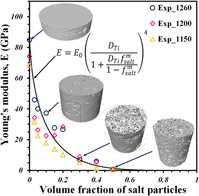Crossref Citations
This article has been cited by the following publications. This list is generated based on data provided by
Crossref.
Olmos, Luis
Bouvard, Didier
Cabezas-Villa, Jose Luis
Lemus-Ruiz, Jose
Jiménez, Omar
and
Arteaga, Dante
2019.
Analysis of Compression and Permeability Behavior of Porous Ti6Al4V by Computed Microtomography.
Metals and Materials International,
Vol. 25,
Issue. 3,
p.
669.
Mihalcea, Elena
Hernández, Héctor Vergara
Olmos, Luis
and
Jimenez, Omar
2019.
Semi-solid Sintering of Ti6Al4V/CoCrMo Composites for Biomedical Applications.
Materials Research,
Vol. 22,
Issue. 2,
Garnica, P.
Macías, R.
Chávez, J.
Bouvard, D.
Jiménez, O.
Olmos, L.
and
Arteaga, D.
2020.
Fabrication and characterization of highly porous Ti6Al4V/xTa composites for orthopedic applications.
Journal of Materials Science,
Vol. 55,
Issue. 34,
p.
16419.
Chávez, Jorge
Jiménez Alemán, Omar
Flores Martínez, Martín
Vergara-Hernández, Héctor J.
Olmos, Luis
Garnica-González, Pedro
and
Bouvard, Didier
2020.
Characterization of Ti6Al4V–Ti6Al4V/30Ta Bilayer Components Processed by Powder Metallurgy for Biomedical Applications.
Metals and Materials International,
Vol. 26,
Issue. 2,
p.
205.
Olmos, L.
Cabezas-Villa, J. L.
Bouvard, D.
Lemus-Ruiz, J.
Jiménez, O.
and
Falcón-Franco, L. A.
2020.
Synthesis and characterisation of Ti6Al4V/xTa alloy processed by solid state sintering.
Powder Metallurgy,
Vol. 63,
Issue. 1,
p.
64.
Olmos, L.
Mihalcea, E.
Vergara-Hernández, H.J.
Bouvard, D.
Jimenez, O.
Chávez, J.
Camacho, N.
and
Macías, R.
2021.
Design of architectured Ti6Al4V-based materials for biomedical applications fabricated via powder metallurgy.
Materials Today Communications,
Vol. 29,
Issue. ,
p.
102937.
Mihalcea, E.
Vergara-Hernández, H. J.
Olmos, L.
Jimenez, O.
Arteaga, D.
and
Salgado-López, J. M.
2021.
X-ray Computed Microtomography Characterization of Ti6Al4V/CoCrMo Biomedical Composite Fabricated by Semi-solid Sintering.
Journal of Nondestructive Evaluation,
Vol. 40,
Issue. 1,
Téllez-Martínez, Jorge Sergio
Olmos, Luis
Solorio-García, Víctor Manuel
Vergara-Hernández, Héctor Javier
Chávez, Jorge
and
Arteaga, Dante
2021.
Processing and Characterization of Bilayer Materials by Solid State Sintering for Orthopedic Applications.
Metals,
Vol. 11,
Issue. 2,
p.
207.
MIHALCEA, E.
VERGARA-HERNÁNDEZ, H.J.
JIMENEZ, O.
OLMOS, L.
CHÁVEZ, J.
and
ARTEAGA, D.
2021.
Design and characterization of Ti6Al4V/20CoCrMo−highly porous Ti6Al4V biomedical bilayer processed by powder metallurgy.
Transactions of Nonferrous Metals Society of China,
Vol. 31,
Issue. 1,
p.
178.
Moreira, Anderson Camargo
Fernandes, Celso Peres
Oliveira, Marize Varella de
Duailibi, Monica Talarico
Ribeiro, Alexandre Antunes
Duailibi, Silvio Eduardo
Kfouri, Flávio de Ávila
and
Mantovani, Iara Frangiotti
2021.
The effect of pores and connections geometries on bone ingrowth into titanium scaffolds: an assessment based on 3D microCT images.
Biomedical Materials,
Vol. 16,
Issue. 6,
p.
065010.
Yang, Guang
Guo, Chongchong
Zhang, Yongdi
Yang, Zongjie
and
Chen, Lei
2021.
Design Method of Porous Titanium Alloy Based on Meta-Structure.
Integrated Ferroelectrics,
Vol. 215,
Issue. 1,
p.
149.
Mihalcea, E.
Olmos, L.
Vergara-Hernández, H. J.
Farias, I.
Chavéz, J.
Jimenez, O.
and
Garnica, P.
2022.
Analysis of in situ gas nitriding by dilatometry of porous Ti6Al4V materials.
Journal of Thermal Analysis and Calorimetry,
Vol. 147,
Issue. 5,
p.
3533.
Macias, Rogelio
Garnica-Gonzalez, Pedro
Olmos, Luis
Jimenez, Omar
Chavez, Jorge
Vazquez, Octavio
Alvarado-Hernandez, Francisco
and
Arteaga, Dante
2022.
Sintering Analysis of Porous Ti/xTa Alloys Fabricated from Elemental Powders.
Materials,
Vol. 15,
Issue. 19,
p.
6548.
Olmos, Luis
Gonzaléz-Pedraza, Ana S.
Vergara-Hernández, Héctor J.
Chávez, Jorge
Jimenez, Omar
Mihalcea, Elena
Arteaga, Dante
and
Ruiz-Mondragón, José J.
2022.
Ti64/20Ag Porous Composites Fabricated by Powder Metallurgy for Biomedical Applications.
Materials,
Vol. 15,
Issue. 17,
p.
5956.
Neto, Francisco Cavilha
Giaretton, Mauricio Vitor
Neves, Guilherme Oliveira
Aguilar, Claudio
Tramontin Souza, Marcelo
Binder, Cristiano
and
Klein, Aloísio Nelmo
2022.
An Overview of Highly Porous Titanium Processed via Metal Injection Molding in Combination with the Space Holder Method.
Metals,
Vol. 12,
Issue. 5,
p.
783.
Cabezas-Villa, J. L.
Lemus-Ruiz, J.
García-Carrillo, A. M.
Jiménez, O.
Camacho, N.
and
Olmos, L.
2023.
Characterization of infiltration process of AZ91E alloy in Ti64 scaffolds.
MRS Advances,
Vol. 8,
Issue. 20,
p.
1112.
Alvarado-Hernández, Francisco
Mihalcea, Elena
Jimenez, Omar
Macías, Rogelio
Olmos, Luis
López-Baltazar, Enrique A.
Guevara-Martinez, Santiago
and
Lemus-Ruiz, José
2023.
Design of Ti64/Ta Hybrid Materials by Powder Metallurgy Mimicking Bone Structure.
Materials,
Vol. 16,
Issue. 12,
p.
4372.
Macías, Rogelio
Olmos, Luis
Garnica, Pedro
Alanis, Ivon
Bouvard, Didier
Chávez, Jorge
Jiménez, Omar
Márquez-Beltrán, César
and
Cabezas-Vila, Jose L.
2024.
Processing of Porous-Core Materials for Bone Implant Applications: A Permeability and Mechanical Strength Analysis.
Coatings,
Vol. 14,
Issue. 1,
p.
65.
Macias, Rogelio
Garnica González, Pedro
Olmos, Luis
Alanis-Fuerte, Ivon
Jimenez, Omar
Alvarado-Hernández, Francisco
Velasco-Plascencia, Melina
and
Ávila-Olivera, Jorge Alejandro
2024.
In Situ Fabrication of Ti-xNb Alloys by Conventional Powder Metallurgy.
Coatings,
Vol. 14,
Issue. 7,
p.
897.
Kobe, Ibrahim Hassan
Salawu, Abdulrahman Asipital
Sunday, Abolarin Mathew
Oyewole, Adedipe
Uzoma, Okoro Gregory
Omoniyi, Peter Olorunleke
and
Jen, Tien-Chien
2025.
Statistical design for optimal physical and biomechanical characteristics of biocomposite prostheses.
Scientific African,
Vol. 27,
Issue. ,
p.
e02593.
